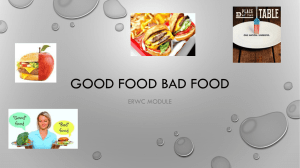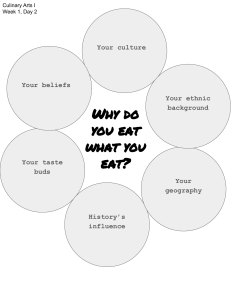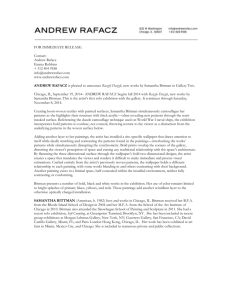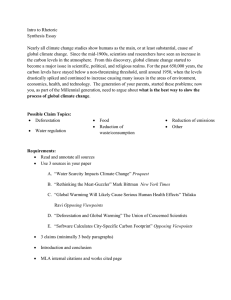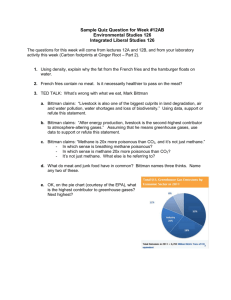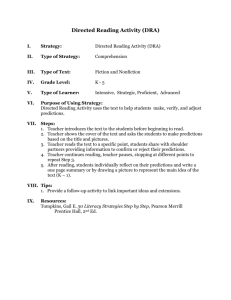Module VI: Good Food/ Bad Food
advertisement
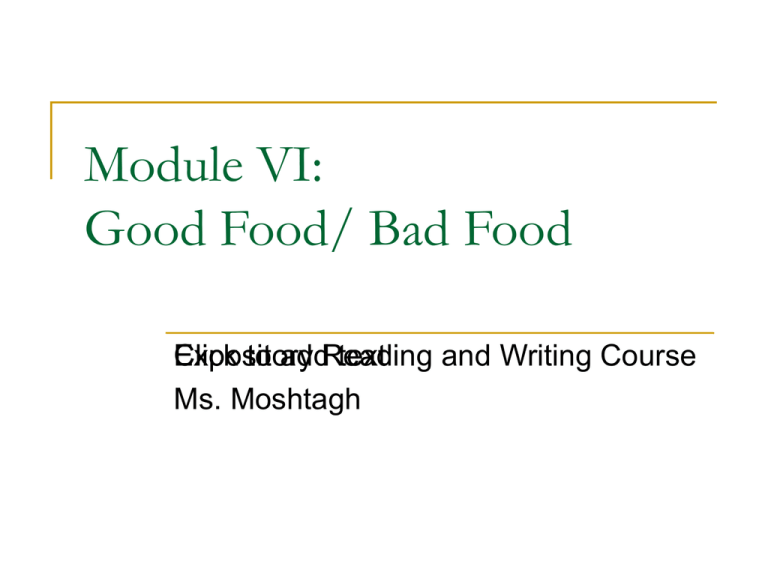
Module VI: Good Food/ Bad Food Expository Click to addReading text and Writing Course Ms. Moshtagh Activity 1: Getting Ready to Read – Quickwrite Americans are at increasing risk of disease because of the unhealthy food we eat. What will it take to get us to change our eating habits? Activity 2: Surveying the Text What do the titles “Attacking the Obesity Epidemic by First Figuring Out Its Cause” and “Bad Food? Tax It, and Subsidize Vegetables” tell you about what the articles will be about? Can you guess what “No Lunch Left Behind” is going to be about from its title? All three articles were published in the New York Times in 2009 and 2011. What can you predict about the articles? How do you think the articles will be the same? How do you think they will be different? Activity 3: Making Predictions – Anticipation Guide Before reading “Attacking the Obesity Epidemic,” indicate in the first column which of the statements below you believe are true and which are false. After reading, go back and label the statements true or false based on what you learned by reading the article. Record the number of the paragraph in which you found the information. Activity 3: Making Predictions – Anticipation Guide Americans now need far fewer calories to be healthy than people did in the 1800s. Since the 1970s, the food industry has made it easier to eat a healthy diet. Efforts to reduce smoking show that it’s almost impossible to get people to change habits. Taxing unhealthy food would be an inexpensive way to improve American health. Offering healthy lunches at school means kids are more likely to eat healthy food at home. Activity 4: Making Predictions and Asking Questions Read the first paragraph of “No Lunch Left Behind” silently. What do Waters and Heron think should happen to school lunches? Now that you’ve read the first paragraph, explain what the title of the article means. Now read the first five paragraphs of “Bad Food?” What is it going to be about? Why does Bittman put a question mark after “Bad Food?” Who do you think is the intended audience for this piece? How do you know this? Is it the same audience for “No Lunch Left Behind?” Turn the title of Bittman’s article into a question to answer as you read the essay. Activity 5: Reading for Understanding “Attacking the Obesity Epidemic” The first reading of an essay: reading “with the grain” or “playing the believing game” Which of your predictions turned out to be true? What surprised you? If your predictions turned out to be wrong, what misled you? Can you answer the question you created from the title? What, if anything, is still confusing to you? Understanding Key Vocabulary Subvert (2) Culpable (5) Laden (6) Crave (11) Push factors (13) Obesogenic (13) Interventions (16) Controversial (24) “Bad Food” Indisputable (1) Fix (4) Subsidizing (5) Staple foods (7) Ubiquitous (17) Borne (21) Precedent (21) Comprehensive (32) Activity 5: Reading for Understanding (continued) Read “with the grain” and “play the believing game” as you read Bittman's “Bad Food?” Circle the words on the previous slide as well as any others you may not know. Define them. Highlight/ underline main ideas Write personal connections/ notes/ symbols in the right column of the article Activity 5: Reading for Understanding (continued) “Bad Food?” Which of your predictions turned out to be true? What surprised you? If your predictions turned out to be wrong, what misled you? Can you answer the question you created from the title? What, if anything, is still confusing to you? Activity 5: Reading for Understanding (continued) Read “with the grain” and “play the believing game” as you read Bittman's “Bad Food?” Identify eight similar key words in “No Lunch Left Behind” Compare your key words with a partner. Did you define different words? Share the meanings and add them to your article Highlight/ underline main ideas Write personal connections/ notes/ symbols in the right column of the article Activity 5: Reading for Understanding (continued) “No Lunch Left Behind” Which of your predictions turned out to be true? What surprised you? If your predictions turned out to be wrong, what misled you? Can you answer the question you created from the title? What, if anything, is still confusing to you? Activity 7: Considering the Structure of the Text – Descriptive Outline Create a descriptive outline of “No Lunch Left Behind” by describing the content of purpose of each section. For example, for the first section (after paragraph 1): Content and Purpose: The National School Lunch Program is a failure and should be reformed to improve children's health. The purpose is to make a recommendation for how to improve children's health Then write a statement summarizing the content and purpose of the entire article on the last page. Activity 8: Considering the Structure of the Text – Quickwrite Do you eat healthy lunches when you are at school? Why or why not? Annotating and Questioning the Text In rereading, it is helpful to read “against the grain” or “play the doubting game.” This is where the conversation about solving the obesity epidemic shifts, and you should begin to question the texts and their authors. As you finish rereading “Bad Food?” make marginal notations: 1. In the left margin, label what the author is saying as follows: The introduction The issue or problem the author is writing about The author's main arguments The author's examples The author's conclusion 2. In the right margins, write your “doubting” reactions in a different color 3. Share your annotations with a partner Did you agree on what the main idea was? Did you mark the same arguments and examples? Did you agree on the conclusion? How did your responses differ? Activity 12: Summarizing and Responding – Rhetorical Précis Use the article with your annotations to help you write a rhetorical précis of Bittman’s article, “Bad Food? Tax It, and Subsidize Vegetables.” Be sure to paraphrase what Bittman says in your own words; do not quote. Activity 12: Summarizing and Responding – Rhetorical Précis Sentence 1: Note the name of the author, the genre and title of the work, the publication date in parentheses; a rhetorically accurate verb, and a “that” clause containing the major assertion or thesis statement of the work. Sentence 2: An explanation of how the author develops and supports the thesis following the order of the article. Activity 12: Summarizing and Responding – Rhetorical Précis Sentence 3: A statement of the author's apparent purpose, followed by an “in order to” phrase. Sentence 4: A description of the intended audience, the relationship the author establishes with the audience, or both. Activity 13: Thinking Critically: NEED QUOTATIONS + CITATIONS Group 1: Questions about Logic (Logos) 1. What are Bittman's major claims and assertions? Do you agree with his claims? 2. What evidence does he use to support his claims? How relevant and valid do you think the evidence is? How sound is the reasoning? Is there any claim that appears to be weak or unsupported? Which one, and why do you think so? 3. What would Brody and Waters and Heron say in response to Bittman's proposal? Activity 13: Thinking Critically NEED QUOTATIONS + CITATIONS Group 2: Questions about the Writer (Ethos) 1. What can you infer about Bittman from the text? Does he have the appropriate background to speak with authority on the subject? Is he knowledgeable on this subject? 2. What does Bittman's style and language tell you about him? 3. Can you trust Bittman based on the evidence he provides and the way he addresses his readers? How trustworthy do you think he is compared to Brody? To Waters and Heron? Activity 13: Thinking Critically NEED QUOTATIONS + CITATIONS Group 3: Questions about Emotions (Pathos) 1. Does “Bad Food?” affect you emotionally? What parts? 2. Do you think Bittman is trying to manipulate your emotions? In what ways? 3. Does Bittman appeal to your emotions more than Brody and Waters and Heron? If so, does that make you agree with his proposal more or less? Activity 14: Designing and Administering a Survey Field research can be a valuable way to gather additional evidence about a problem and the ways people might respond to possible solutions. You will now administer a survey to students at your school. Designing and Administering a Survey – 3rd period Directions: This survey is designed to find out more about the eating habits and preferences of students at our school. Please answer Y (yes) or N (no) to the following statements. Your name will not appear on the survey. ______ 1. Do you drink a sugar-sweetened beverage at least once a day? ______ 2. Do you dine out at least twice a week? ______ 3. Do you get your recommended amount of fruits and vegetables daily? ______ 4. Would you be in favor of a higher tax on unhealthy food? Designing and Administering a Survey – 5th period Directions: This survey is designed to find out more about the eating habits and preferences of students at our school. Please answer Y (yes) or N (no) to the following statements. Your name will not appear on the survey. ______ 1. Do you drink a sugar-sweetened beverage at least once a day? ______ 2. Do you think Foothill offers healthy food choices? ______ 3. Do you exercise for at least 30 minuets, five times a week? ______ 4. Do you look at the nutrition facts on the foods you buy before purchasing them? Activity 16: Considering the Speaking Task You have learned about and discussed different causes of the obesity epidemic, including the unhealthy food available to students in schools and young peoples’ unhealthy eating habits. For this project, you will write a proposal for how to encourage healthier eating at your school. Further Instructions are on handout Activity 17: Taking a Stance As you review your annotated reading, quickwrites, summaries, predictions, and answers to the critical reading questions, consider how you would propose encouraging healthier eating at your school. Brainstorm possible ideas, and select the one that you feel would have the biggest impact in your particular setting. Then write answers to the following questions as you begin to think about your speech. (on next slide) Activity 17: Taking a Stance • • • • • • • • What is your proposal for encouraging healthier eating at your school? Who is your audience? Why should they agree with your proposal? How does your idea relate to what others have to say about encouraging healthy eating? What might others say in response to your proposal? Who might agree and who might disagree with it? What evidence from the readings and research, including the data from the survey, will persuade your audience to agree with your proposal? How much background information will your audience need to understand your proposal? What will those who disagree with your proposal have to say about it? What evidence might they use? How did your views change during your reading and research? What factors caused you to change? Could you use these factors to change someone else’s view? Gathering Evidence to Support Your Claims • “Attacking the Obesity Epidemic by First Figuring Out Its Cause” by Jane E. Brody • “Bad Food? Tax It, and Subsidize Vegetables” by Mark Bittman • “No Lunch Left Behind” by Alice Waters and Katrina Heron • “My 600 lb Life” – Penny and Melissa’s Stories • Dr. Robert C. and Veronica Atkins Center for Weight and Health, UC Berkeley http://cwh.berkeley.edu/resources/2/20/53/16%2C38%2C96 • Michael Pollan http://michaelpollan.com • Food Inc. http://www.takepart.com/foodinc • The Edible Schoolyard http://edibleschoolyard.org • Yale Rudd Center for Food Policy and Obesity http://www.yaleruddcenter.org Activity 18: Considering Structure The content of your proposal should include the following: 1. Provide the background of your proposal. You will need to consider the answers to the following questions: What’s your purpose in writing the proposal? Who is the target audience for your proposal? How much does your target audience understand about the problem? What kind of attitude (positive or negative) does your target audience have toward you? Why do you think your target audience might help you solve the problem? What strategies do you plan to use to convince your target audience? Activity 18: Considering Structure 2. Clarify the problem. Describe the problem specifically, and explain why it potentially affects students at your school. Also, consider answering the following questions: Which cause seems to contribute most significantly to the problem? What have other people said about the problem? What data confirm the importance of the problem? Present your evidence to support your opinions. Activity 18: Considering Structure 3. Propose the best solution to the problem. Consider answering the following questions: What different solutions have others proposed? What is your solution? Be specific about what your target audience should do to help you solve the problem. Why do you think your solution is the most practical and the best? What evidence can you use to justify your solution?
